Accuracy and consistency are a big part of good graphic design. Recreating jobs for clients requires accuracy and consistency. This is very important for official documents that your clients may have and need to keep looking the same. Knowing how to create and use Color Swatches in Photoshop is very important for accuracy and consistency.

A swatch is defined as a sample strip cut from a piece of material, a representative portion, or a sample. A swatch is also defined as a small piece of cloth used as an example of the color and type of the cloth. In graphic designing, a swatch is a little sample of colors, gradients, or patterns that are saved for sampling. In Photoshop swatches are square samples of colors that are used to save colors for use, the swatch panel is at the top right of the workspace. Photoshop has default color swatches that can be used. Photoshop also offers the option for users to create and save custom color swatches.
Create and use Color Swatches in Photoshop
Custom color swatches can be used to save the color of items such as plants, fruits, seasons, logos, etc. creating custom swatches is also important for accurate color reproduction. For example, when you look at a ripe sweet pepper (bell pepper) you realize that there are different shades to the color. These colors are based on the ripeness of different sections, how the light hits the pepper, the direction of the light, and so on. Even the stem will have different shades, this means that the swatch will have to be created and labeled to take into consideration all these factors. You would create the swatches and give descriptive names so you know where each would fit when you are recreating a copy of the object.
- Open the Image to be samples
- Delete Default Swatches
- Sample color
- Save color to swatches panel
- Save swatches as set
- Return default swatches
- Using your custom swatches
1] Open the Image to be sampled
The image that will be used is a ripe red sweet pepper (bell pepper). Open Photoshop and go to File then Open. Search for the file that you want then click Open.
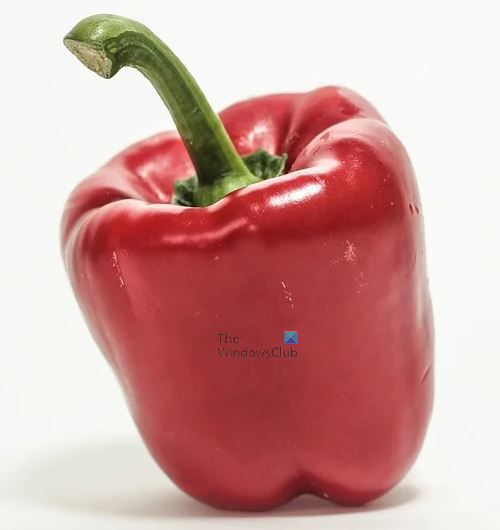
Observe the image and take note of all the different shades that are there. If you need to reproduce this image, you will need to reproduce all the colors as accurately as possible.
2] Delete Default Swatches
Before saving your custom swatches, you should delete the default swatches. This will help to make it easier to make and group your custom swatches. The default swatches can be returned as they are not fully deleted, they are only removed from display.
To delete the default color swatches, go to the swatches panel and delete each color swatch. Photoshop does not have a button to delete all swatches so you can delete them one by one or go through the Preset manager.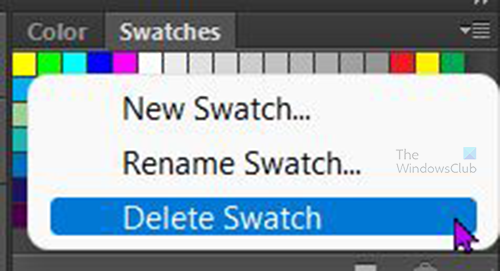
To delete the swatches one by one, go to the swatch panel and right click on each, and click Delete.
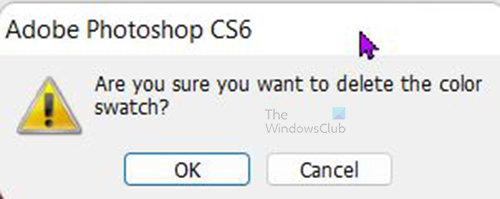
You will be asked to confirm the delete, press Ok to confirm, or Delete to cancel.
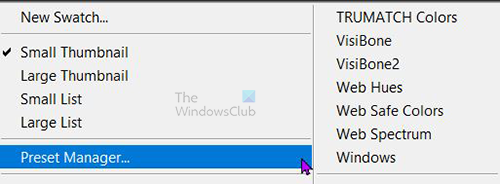
To delete the swatches using Preset manager is the easiest way to delete all the swatches at once. Go to the swatches panel, and click the menu at the top right. On the drop down menu, click Preset manager.
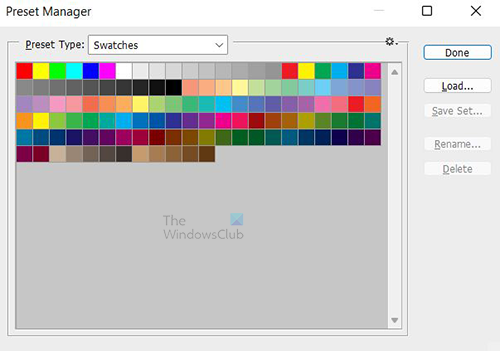
The Preset manager window opens and you will see the color swatch.
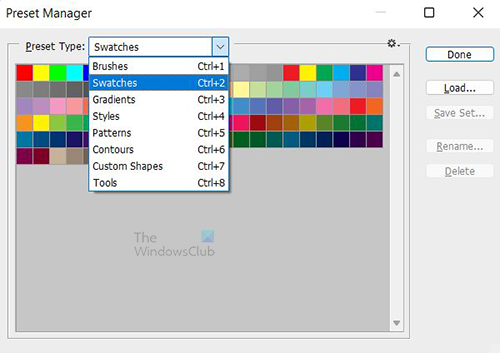
You can click the down arrow at Preset type and the different presents will be seen in the list. Click any one will show the different presets such as brushes, swatches, patterns, etc.
To delete all the color swatches click the first one then hold Shift and click the last one, then press Delete. When all the swatches are deleted, press Done and all the swatches on the swatches panel will be deleted. You can get the swatches back by going to the swatches panel then pressing the menu then pressing Reset Swatches. All the color swatches will return to the swatches panel.
3] Sample color
It is not time to sample and save the colors to the swatch panel. Go to the Tools menu on the left and select the Eyedropper tool or press I. click on the regions of the image that you want to sample. In the case of the sweet pepper, click on all the different colors and give them descriptive names. Here I will start with the stem and sample the different shades of green found there. To keep this short, only two colors will be sampled from the stem.
Hover the Eyedropper tool over the color and click it. You will be sure of what you select by looking at the Foreground color on the Tools panel on the left.

When you click on the color with the Eyedropper tool, a sampling circle will appear.
4] Save colors to swatches panel
When you are satisfied that the correct color is sampled, go over to the swatches panel and click there and a window will appear for you to name the color.

Give the color a descriptive name and press Ok to confirm or Cancel to dismiss. If you press Ok the color will be placed on the swatch panel.
You can hover over the color in the swatches panel with the mouse and you will see the name of the color you sampled. Use the eyedropper tool to keep sampling all the colors you need and add them to the swatches panel.
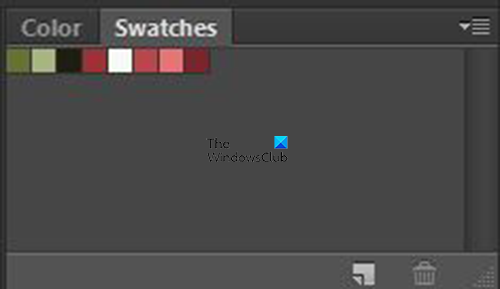
This is what the color swatches panel looks like with the colors from the sweet pepper. You could get more or fewer colors, but that will be dependent on how detailed you want to make your artwork when you decide to reproduce a sweet pepper. The colors can also be used for different artworks that you want to color.
5] Save swatches as a swatch set
Now that you have all the colors that you need you can make save the colors as a swatch set. That is like saving them in folders.
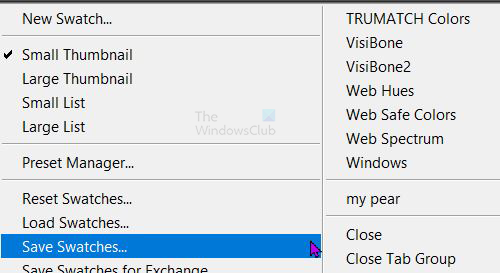
To save the swatches as a swatch set, go to the swatches panel and click on the menu button at the top right. The drop-down menu will appear, click Save swatches.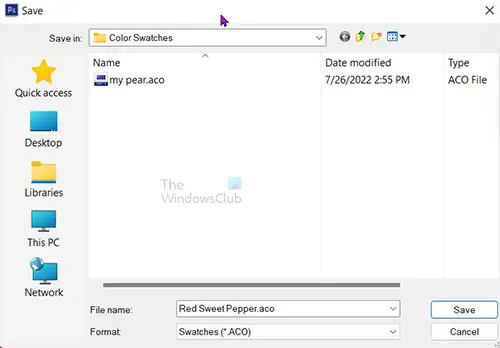
The Save dialogue box will appear and you type the name you want for the group of colors. Choose a descriptive name for the group. This group will be named Red Sweet Pepper so that it is easy to remember what it is for.
6] Return default swatches
Now that the custom swatches have been made and grouped, it is time to bring back the default swatches.
To return the default swatches go to the swatches panel and click the menu button at the top right of the swatches panel.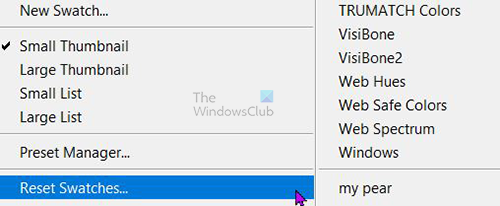
From the drop-down menu, choose Reset swatches.

Photoshop will ask if you want to replace current color swatches with the default ones. Click Append to keep the custom color swatches and the default color swatches or click Ok to replace the custom swatches with the default swatches. I will click ok to replace the custom swatches with the default swatches.
7] Using your custom swatches
Whenever you want to use the custom color swatches you have created you can just load them. To load them go to the swatches panel and click the menu button at the top right of the swatches panel. You will see a list of other available swatch sets. These are other swatch sets that come with Photoshop. The custom swatch sets are saved in the same place as these other swatch sets.
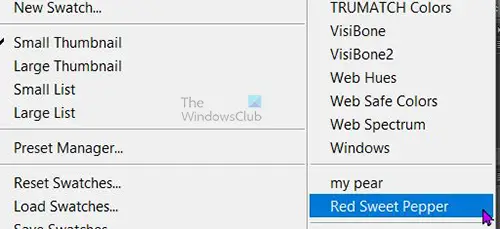
Click on the name of the custom swatch set that you created. The custom swatch set is near Red Sweet Pepper.
Photoshop will ask if you want to replace current color swatches with the custom ones (Red Sweeet Pepper). Click Ok to replace the default ones with the custom ones or click Append to keep both in the swatches panel. For this article, the default ones will be replaced by clicking Ok.
How to use swatch colors for foreground and background color?
The swatch color can be used for colors in your artwork. The color swatches make it easier to use colors easily and consistently. Whenever you are ready for color, simply move to the color swatch and click on a color and it will be the foreground color. When you click on the color in the color swatch, the foreground color will change at the left tools panel. That color will be the color for any text that you choose.
Read: How to make a Color Photo look like a Sketch in Photoshop CS6
How do I create a custom color Swatch?
To create a custom color Swatch in Photoshop, you need to have the subject first. Then, you can cut a portion of the image that you want to use as the source of colors. Following that, you can use the Swatches panel to save the colors at once. For your information, you can find your custom Swatch in the Swatches section on the right-hand side.
Leave a Reply